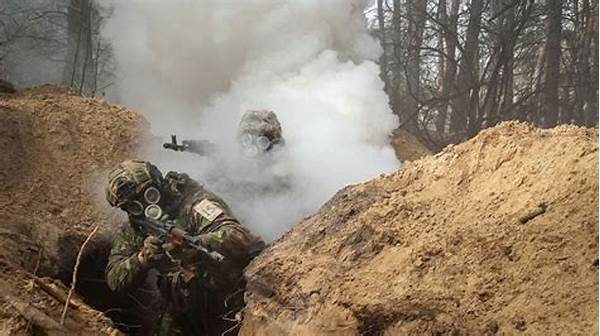The use of chemical weapons presents a profound challenge to both environmental and public health. These harmful substances, when deployed, lead to a cascade of pollution scenarios that permeate ecosystems and human habitats. This article aims to elucidate the extent and impact of pollution from chemical weapons use, while exploring potential mitigation strategies.
Environmental Consequences
Pollution from chemical weapons use has far-reaching implications on the environment. The dispersal of toxic agents into the air, soil, and water bodies leads to the contamination of ecosystems. Vegetation, crucial for maintaining ecological balance, suffers immediate decay when exposed to such pollutants. Wildlife, including various species of flora and fauna, also face severe disruptions in their life cycles due to these hazardous substances. Furthermore, the bioaccumulation of toxic chemicals in the food chain can lead to catastrophic effects, not only affecting animal populations but also posing a risk to human health through the consumption of contaminated food products. The persistence of these chemicals in the environment implies that their impact continues long after their use, necessitating robust measures for environmental restoration.
The pollution from chemical weapons use is not limited to ecosystems but extends to built environments. Urban areas affected by chemical warfare agents experience air quality deterioration. The sedimentation of these toxins in water bodies eventually impacts water resources that are essential for both residential and agricultural uses. As such, it becomes imperative for nations and international bodies to collaborate in developing comprehensive policies and protocols aimed at the containment and eventual eradication of chemical weapon remnants.
Human Health Impact
The pollution from chemical weapons use poses severe health risks to human populations. Respiratory illnesses are prevalent among communities exposed to airborne toxic agents, as these pollutants compromise lung function. Prolonged exposure to chemical contaminants can lead to chronic ailments such as cancers and neurologic disorders. Children are particularly vulnerable, with developmental issues often arising due to early exposure.
Addressing the pollution from chemical weapons use is critical for safeguarding public health. Initiatives must include extensive medical surveillance, adequate health facilities for the affected, and public awareness campaigns to mitigate the long-term impact. The global community must prioritize medical research to develop antidotes and treatments for related illnesses, ensuring that affected populations receive timely medical intervention.
Legal and Ethical Considerations
The utilization of chemical weaponry raises significant legal and ethical concerns. Pollution from chemical weapons use is a direct violation of international treaties such as the Chemical Weapons Convention, which seeks to eliminate chemical arms and mandates the peaceful application of chemistry. The destruction such weapons inflict on both human life and the environment calls for stringent legal frameworks, ensuring perpetrators face accountability.
Moreover, ethical considerations necessitate transparency in government and military operations concerning chemical weapons. The global community must engage in dialogue to reinforce regulatory mechanisms, ensuring compliance with international standards. Educational initiatives should be implemented to inform stakeholders of the legal repercussions and ethical considerations surrounding the pollution from chemical weapons use.
Economic Impact
1. The economic consequences of pollution from chemical weapons use are substantial, affecting multiple sectors. Agriculture suffers as soil quality degrades, leading to reduced crop yields.
2. Healthcare systems bear a significant burden due to the treatment of diseases caused by toxic exposure, straining financial resources.
3. Tourism in regions impacted by chemical contamination decreases, affecting local economies reliant on tourist influx.
4. Cleanup and decontamination efforts require significant investment, diverting public funds from other essential services.
5. The long-term pollution from chemical weapons use necessitates continuous monitoring and research, requiring sustained financial commitment.
Remediation Strategies
Remediation of environments affected by chemical weapon use is a complex and urgent task. Pollution from chemical weapons use can be addressed through multi-faceted approaches. Technological innovations play a pivotal role, with advancements in decontamination technology offering promising results in the removal of toxic agents from affected areas. Bioremediation, which uses microorganisms to break down hazardous substances, has proven effective in certain contexts and represents a sustainable cleanup method.
Furthermore, international cooperation is paramount in addressing cleanup efforts, as pollution from chemical weapons use often transcends national borders. Countries must come together to share expertise, resources, and technology. Additionally, legislative frameworks should be stringent enough to prevent future occurrences, coupled with enforcement mechanisms to ensure compliance. These efforts, if systematically applied, can significantly reduce the enduring footprint of chemical weapons on global health and the environment.
International Collaboration
International collaboration is essential in tackling the issue of pollution from chemical weapons use. The complexity and scale of this issue require a unified response grounded in mutual trust and cooperation. Countries must adhere to international treaties and conventions, ensuring transparent communication and a commitment to chemical disarmance.
Organizations such as the United Nations and the Organisation for the Prohibition of Chemical Weapons play pivotal roles in facilitating dialogue and coordinating efforts. Collaborative research initiatives aimed at developing innovative solutions for decontamination must be encouraged. Furthermore, sharing best practices and technological advancements ensures that affected nations can rapidly and effectively address pollution from chemical weapons use, ultimately protecting both environmental and human health.
Summary
Pollution from chemical weapons use represents a grave threat to the environment, public health, and global economic stability. Addressing this issue demands a concerted effort from governments, international organizations, and societies. The environmental damage wrought by chemical contamination is profound, affecting ecosystems and human health alike.
The pathway to mitigation involves legal, ethical, and scientific initiatives aimed at prevention and restoration. Through collaborative efforts in research and policy-making, there can be progress in reducing the pollution from chemical weapons use. Ultimately, a commitment to peace and disarmament remains crucial in ensuring a safer and cleaner world for future generations.





